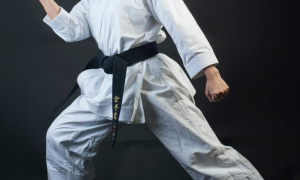
In the world of martial arts, the choice between different disciplines can be as personal as it is pivotal. So which martial art is right for me? Among the myriad options, two contenders with unique philosophies, techniques, and applications are – Taekwondo and Aikido. This exploration aims to shed light on the distinctions between these two captivating martial arts, helping you navigate the path to choosing the one that resonates with you.
Table of Contents
ToggleAikido vs Taekwondo
These words conjure images of dynamic kicks and graceful movements, of strength and harmony, of combat and philosophy. This article delves into the comparison of Taekwondo vs Aikido. The canvas of comparison is broad, encompassing not only the physicality of these martial arts but also the mindset they cultivate and the practicality they offer in real-world scenarios.
In short:
Taekwondo is all about powerful leg kicks and quick moves, while Aikido is more about using an opponent’s energy and momentum to control them using throws and holds. Taekwondo goes for strong strikes, speed, and agility, while Aikido aims for balance, harmony, and using techniques that don’t rely on force. These differences capture the unique approaches each martial art takes in its teachings and techniques.
Understanding Aikido
Aikido: The Art of Harmony and Redirecting Energy
At the heart of Aikido lies a philosophy that transcends physical combat, reaching into the realms of harmony and mutual understanding. Developed by Morihei Ueshiba in Japan during the early 20th century, Aikido is often described as the art of using an opponent’s energy against them. Unlike martial arts which rely more on brute force and aggression, Aikido focuses on redirection, balance, and joint manipulation to subdue an attacker while minimizing harm.
Philosophy of Aikido
Central to Aikido is a philosophy that values peace and non-violence. The core principle of Aikido is to blend with an opponent’s attack and redirect their energy, rather than meeting force with force. Practitioners of Aikido seek to neutralize conflict without causing harm. This philosophy extends beyond the training mat and into daily life, emphasizing the cultivation of a harmonious and compassionate mindset.
Techniques of Aikido
Aikido techniques are characterized by their fluidity and circular movements. Practitioners use their opponent’s momentum to create openings for joint locks, throws, and pins. These techniques exploit an attacker’s vulnerability while ensuring their safety. By focusing on precise timing and subtle shifts in balance, Aikido practitioners can control and subdue even larger opponents.
Practical Applications of Aikido
Aikido’s emphasis on non-violence and conflict resolution makes it suitable for self-defense scenarios where minimizing harm is essential. While Aikido techniques can effectively immobilize an opponent, the goal is to neutralize the threat without causing undue injury. This makes Aikido particularly well-suited for situations involving an uncooperative or aggressive opponent. Aikido practitioners learn to adapt their techniques to varying levels of force, making it a versatile martial art for real-world encounters.
Can Aikido Beat Taekwondo?
Aikido’s focus on redirection and joint manipulation stands in contrast to Taekwondo’s emphasis on striking and agility. In a controlled setting where Aikido’s principles are skillfully employed, it can effectively neutralize an opponent’s attacks and minimize harm. However, in a confrontation against a skilled Taekwondo practitioner’s potent kicks and strikes, Aikido’s effectiveness is often outmatched. Notably, Taekwondo typically holds the advantage in MMA or UFC-style fights due to its higher suitability for such competitive formats.
Understanding Taekwondo
Taekwondo: The Art of Dynamic Strikes and Agility
Originating in Korea, Taekwondo is a martial art that captivates with its explosive high kicks, fast footwork, and powerful strikes. With its roots dating back to ancient Korean traditions, Taekwondo has evolved into a modern combat sport and self-defense system that showcases impressive acrobatics and an emphasis on agility, speed, and precision.
Philosophy of Taekwondo
Taekwondo’s philosophy is deeply rooted in self-discipline, respect, and perseverance. Practitioners of this martial art dedicate themselves not only to mastering techniques but also to cultivating mental and physical toughness. The guiding principles of Taekwondo extend beyond the training mat, promoting values of integrity, courtesy, and indomitable spirit. This focus on character development alongside combat skills sets Taekwondo apart as a holistic martial art.
Techniques of Taekwondo
Taekwondo’s techniques are characterized by their dynamic nature and emphasis on striking. Practitioners develop a repertoire of high, swift kicks, and punches. These techniques are often combined in choreographed sequences called forms (poomsae or hyung). Additionally, Taekwondo incorporates a range of blocks and evasions to defend against attacks.
Practical Applications of Taekwondo
Taekwondo’s techniques make it effective for self-defense situations that demand quick reflexes and agile movements. Its emphasis on strikes and kicks allows practitioners to create distance from an attacker and immobilize them with well-placed blows. However, Taekwondo also emphasizes self-control and restraint, ensuring that its powerful techniques are used responsibly. While Taekwondo can be utilized effectively for self-defense, it’s essential to consider factors such as the practitioner’s skill level and the nature of the confrontation.
Aikido vs. Taekwondo – A Comparative Analysis
The techniques employed by Aikido and Taekwondo mirror their philosophical differences. Aikido practitioners engage in fluid, circular movements, redirecting an attacker’s force to control and incapacitate. In contrast, Taekwondo’s arsenal boasts swift, powerful strikes, high kicks, and dynamic footwork. Aikido’s approach centers on the art of redirection, while Taekwondo emphasizes decisive offensive and defensive maneuvers.
Application in Real-World Scenarios
When considering Aikido and Taekwondo’s effectiveness in self-defense, nuances emerge. Aikido’s principles enable practitioners to manage and subdue an opponent without causing injury. Taekwondo’s swift strikes and agile movements empower practitioners to fend off attackers, creating opportunities to escape or incapacitate. The decision between Aikido and Taekwondo hinges on personal preferences and circumstances, such as the likelihood of encountering physical aggression.
Aikido and Taekwondo in Practical Situations and MMA
Real-World Effectiveness and MMA Presence
The practicality of Aikido and Taekwondo is exposed when applied in real-world scenarios and the dynamic world of Mixed Martial Arts (MMA). Let’s delve into their effectiveness and the ways they influence the MMA landscape.
Aikido and Taekwondo in MMA
The realm of Mixed Martial Arts (MMA) offers a platform to gauge the practicality of various martial arts. While Taekwondo’s dynamic kicks and striking techniques are valued in MMA for their potential to inflict damage, Aikido’s redirection techniques present little to no threat within the environment of MMA bouts. MMA fighters often integrate aspects of Taekwondo into their skill set, leveraging its agility and striking precision. It is rare to find successful fighters with an extensive Aikido background, partially due to the temperament and purpose of the martial art not being compatible with the aims of bouts like those seen in the UFC.
Notable MMA Practitioners
Several MMA fighters have backgrounds in Taekwondo but almost none in Aikido:
- Taekwondo-Rooted Fighters: MMA fighters like Conor McGregor and Anthony Pettis have successfully incorporated Taekwondo’s high kicks and agility into their fighting style, demonstrating the art’s effectiveness in delivering impactful strikes.
- Aikido-Influenced Fighters: While Aikido’s presence in MMA is almost zero, some fighters have integrated its principles into their training. However, Aikido’s redirection-based techniques are often not adaptable to the demands of MMA’s competitive environment.
Addressing Common Questions and Myths
Clarifying Misconceptions and Addressing Questions
As the intriguing journey through the realms of Aikido and Taekwondo unfolds, it’s essential to address common questions and debunk myths that often surround these martial arts. Let’s explore some frequently asked questions to provide comprehensive clarity.
What is the Difference Between Aikido and Taekwondo?
Aikido’s emphasis on redirecting energy, joint locks, and harmonious resolution sets it apart from Taekwondo’s focus on striking, high kicks, and agility. Both martial arts require cross-training to make a practitioner suitable for MMA fights. However, Taekwondo holds the edge over Aikido when it comes to its usefulness within combat sports.
Is Aikido Useful in a Street Fight?
The practicality of Aikido in a street fight hinges on its philosophy of non-violence and redirection. Aikido techniques enable practitioners to neutralize attackers without causing undue harm, making it a viable choice for some self-defense scenarios. However, the effectiveness of Aikido relies on proper training and the practitioner’s ability to adapt to the chaotic nature of real-world confrontations.
What Can Beat Aikido?
No martial art is invincible, and Aikido is no exception. Martial artists trained in striking arts, and grappling techniques, or those who excel in close-quarters combat present heavy challenges for Aikido practitioners. Aikido’s effectiveness also depends on the practitioner’s skill level and adaptability. In a dynamic confrontation, versatility and the ability to combine techniques from various martial arts can provide a strategic advantage.
Are There Any Kicks in Aikido?
While Aikido’s focus is not primarily on high kicks like Taekwondo, it does incorporate kicking techniques. Aikido’s kicks are often low and aimed at disrupting an opponent’s balance, complementing its redirection techniques. These kicks serve to create openings for joint locks, throws, and other control techniques that are the core of Aikido’s methodology.
Does Aikido Have Punches and Kicks?
Aikido’s approach to strikes is different from striking-focused martial arts like Taekwondo. While Aikido’s primary emphasis is on joint locks, throws, and redirection, it does include strikes such as punches. These strikes are utilized to maintain distance, create openings, or provide a distraction in conjunction with Aikido’s overarching principles.
Is Krav Maga Similar to Aikido?
Krav Maga and Aikido are distinct martial arts with unique methodologies and philosophies. Krav Maga, developed for self-defense and combat situations, prioritizes practical techniques for neutralizing threats efficiently. Aikido, rooted in harmony and non-violence, focuses on redirecting energy and utilizing an opponent’s force against them. While both arts have self-defense elements, their principles and techniques differ significantly.


